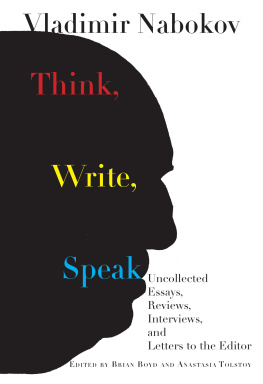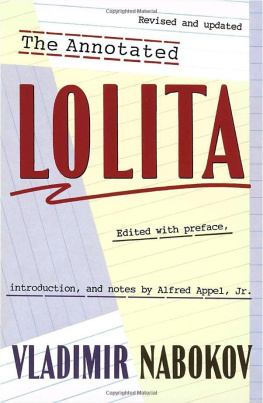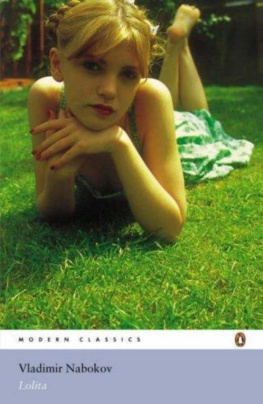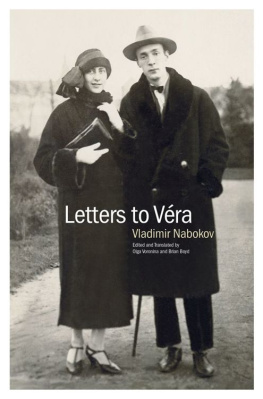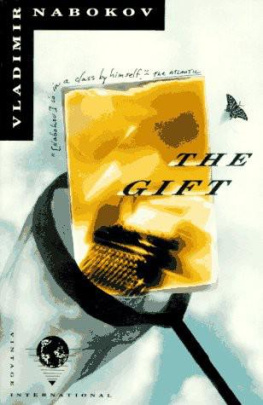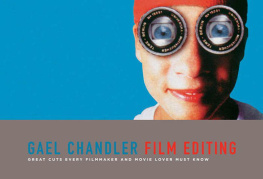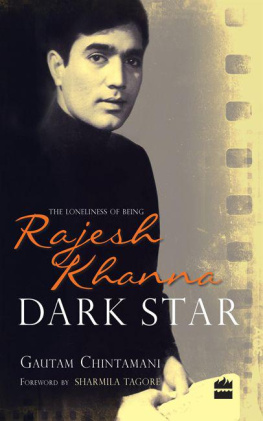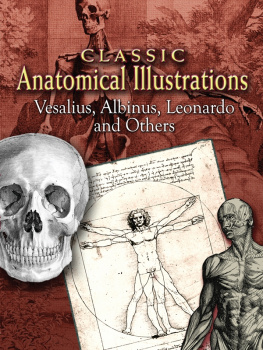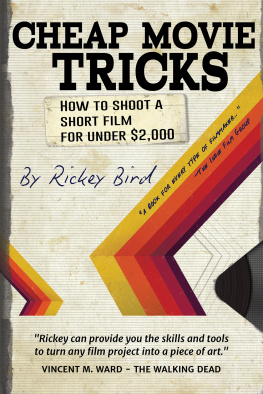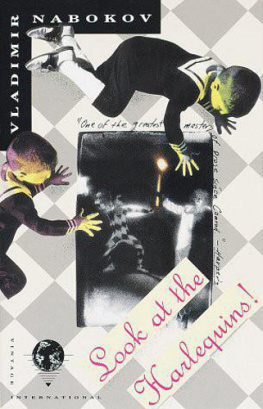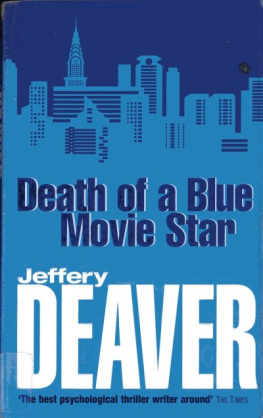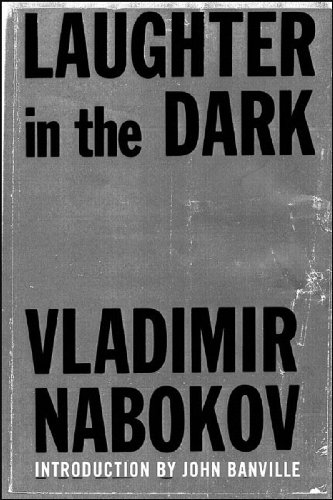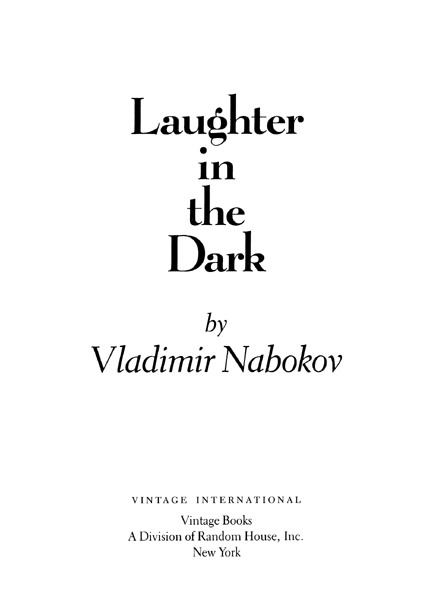BOOKS BY Vladimir Nabokov
NOVELS
Mary
King, Queen, Knave
The Luzhin Defense
The Eye
Glory
Laughter in the Dark
Despair
Invitation to a Beheading
The Gift
The Real Life of Sebastian Knight
Bend Sinister
Lolita
Pnin
Pale Fire
Ada, or Ardor: A Family Chronicle
Transparent Things
Look at the Harlequins!
The Original of Laura
SHORT FICTION
Nabokovs Dozen
A Russian Beauty and Other Stories
Tyrants Destroyed and Other Stories
Details of a Sunset and Other Stories
The Enchanter
DRAMA
The Waltz Invention
Lolita: A Screenplay
The Man from the USSR and Other Plays
AUTOBIOGRAPHY AND INTERVIEWS
Speak, Memory: An Autobiography Revisited
Strong Opinions
BIOGRAPHY AND CRITICISM
Nikolai Gogol
Lectures on Literature
Lectures on Russian Literature
Lectures on Don Quixote
TRANSLATIONS
Three Russian Poets: Translations of Pushkin,
Lermontov, and Tiutchev
A Hero of Our Time (Mikhail Lermontov)
The Song of Igors Campaign (Anon.)
Eugene Onegin (Alexander Pushkin)
LETTERS
Dear Bunny, Dear Volodya:
The Nabokov-Wilson Letters, 19401971
Vladimir Nabokov: Selected Letters, 19401977
MISCELLANEOUS
Poems and Problems
The Annotated Lolita

F IRST V INTAGE I NTERNATIONAL E DITION , D ECEMBER 1989
Copyright 1938 by Bobbs-Merrill Company
Copyright renewed 1965 by Vladimir Nabokov
All rights reserved under International and Pan-American Copyright Conventions. Published in the United States by Vintage Books, a division of Random House, Inc., New York. Originally published, in different form, by Bobbs-Merrill Company in 1938. This edition originally published by New Directions Publishing Corp. in 1960. This edition published by arrangement with the Estate of Vladimir Nabokov and New Directions Publishing Corp.
Library of Congress Cataloging-in-Publication Data
Nabokov, Vladimir Vladimirovich, 1899-1977.
[Kamera obskura. English]
Laughter in the dark / by Vladimir Nabokov. 1st
Vintage international ed.
p. cm.(Vintage international)
Translation of: Kamera obskura.
Originally published in paperback by New Directions
PaperbookT.p. verso.
eISBN: 978-0-307-78767-5
I. Title.
PG3476.N3K313 1989
891.7342-dc20 89-40060
Cover art by Dave Eggers
Cover photograph by Alison Gootee.
v3.1
to Vra
Contents
1
O NCE upon a time there lived in Berlin, Germany, a man called Albinus. He was rich, respectable, happy; one day he abandoned his wife for the sake of a youthful mistress; he loved; was not loved; and his life ended in disaster.
This is the whole of the story and we might have left it at that had there not been profit and pleasure in the telling; and although there is plenty of space on a gravestone to contain, bound in moss, the abridged version of a mans life, detail is always welcome.
It so happened that one night Albinus had a beautiful idea. True, it was not quite his own, as it had been suggested by a phrase in Conrad (not the famous Pole, but Udo Conrad who wrote the Memoirs of a Forgetful Man and that other thing about the old conjuror who spirited himself away at his farewell performance). In any case, he made it his own by liking it, playing with it, letting it grow upon him, and that goes to make lawful property in the free city of the mind. As an art critic and picture expert he had often amused himself by having this or that Old Master sign landscapes and faces which he, Albinus, came across in real life: it turned his existence into a fine picture gallerydelightful fakes, all of them. Then, one night, as he was giving his learned mind a holiday and writing a little essay (nothing very brilliant, he was not a particularly gifted man) upon the art of the cinema, the beautiful idea came to him.
It had to do with colored animated drawingswhich had just begun to appear at the time. How fascinating it would be, he thought, if one could use this method for having some well-known picture, preferably of the Dutch School, perfectly reproduced on the screen in vivid colors and then brought to lifemovement and gesture graphically developed in complete harmony with their static state in the picture; say, a pot-house with little people drinking lustily at wooden tables and a sunny glimpse of a courtyard with saddled horsesall suddenly coming to life with that little man in red putting down his tankard, this girl with the tray wrenching herself free, and a hen beginning to peck on the threshold. It could be continued by having the little figures come out and then pass through the landscape of the same painter, with, perhaps, a brown sky and a frozen canal, and people on the quaint skates they used then, sliding about in the old-fashioned curves suggested by the picture; or a wet road in the mist and a couple of ridersfinally, returning to the same tavern, little by little bringing the figures and light into the selfsame order, settling them down, so to speak, and ending it all with the first picture. Then, too, you could try the Italians: the blue cone of a hill in the distance, a white looping path, little pilgrims winding their way upward. And even religious subjects perhaps, but only those with small figures. And the designer would not only have to possess a thorough knowledge of the given painter and his period, but be blessed with talent enough to avoid any clash between the movements produced and those fixed by the old master: he would have to work them out from the pictureoh, it could be done. And the colors they would be sure to be far more sophisticated than those of animated cartoons. What a tale might be told, the tale of an artists vision, the happy journey of eye and brush, and a world in that artists manner suffused with the tints he himself had found!
After a while he happened to speak of it to a film-producer, but the latter was not in the least excited: he said it would entail a delicacy of work calling for novel improvements in the method of animation, and would cost a whole lot of money; he said such a film, owing to its laborious designing, could not reasonably run longer than several minutes; that even then it would bore most people to death and be a general disappointment.
Then Albinus discussed it with another cinema man, and he too pooh-poohed the whole business. We could begin by something quite simple, said Albinus, a stained window coming to life, animated heraldry, a little saint or two.
Im afraid its no good, said the other. We cant risk fancy pictures.
But Albinus still clung to his idea. Eventually he was told of a clever fellow, Axel Rex, who was a wonderful hand at freakshad, as a matter of fact, designed a Persian fairy tale which had delighted highbrows in Paris and ruined the man who had financed the venture. So Albinus tried to see him, but learned that he had just returned to the States, where he was drawing cartoons for an illustrated paper. After some time Albinus managed to get in touch with him and Rex seemed interested.


